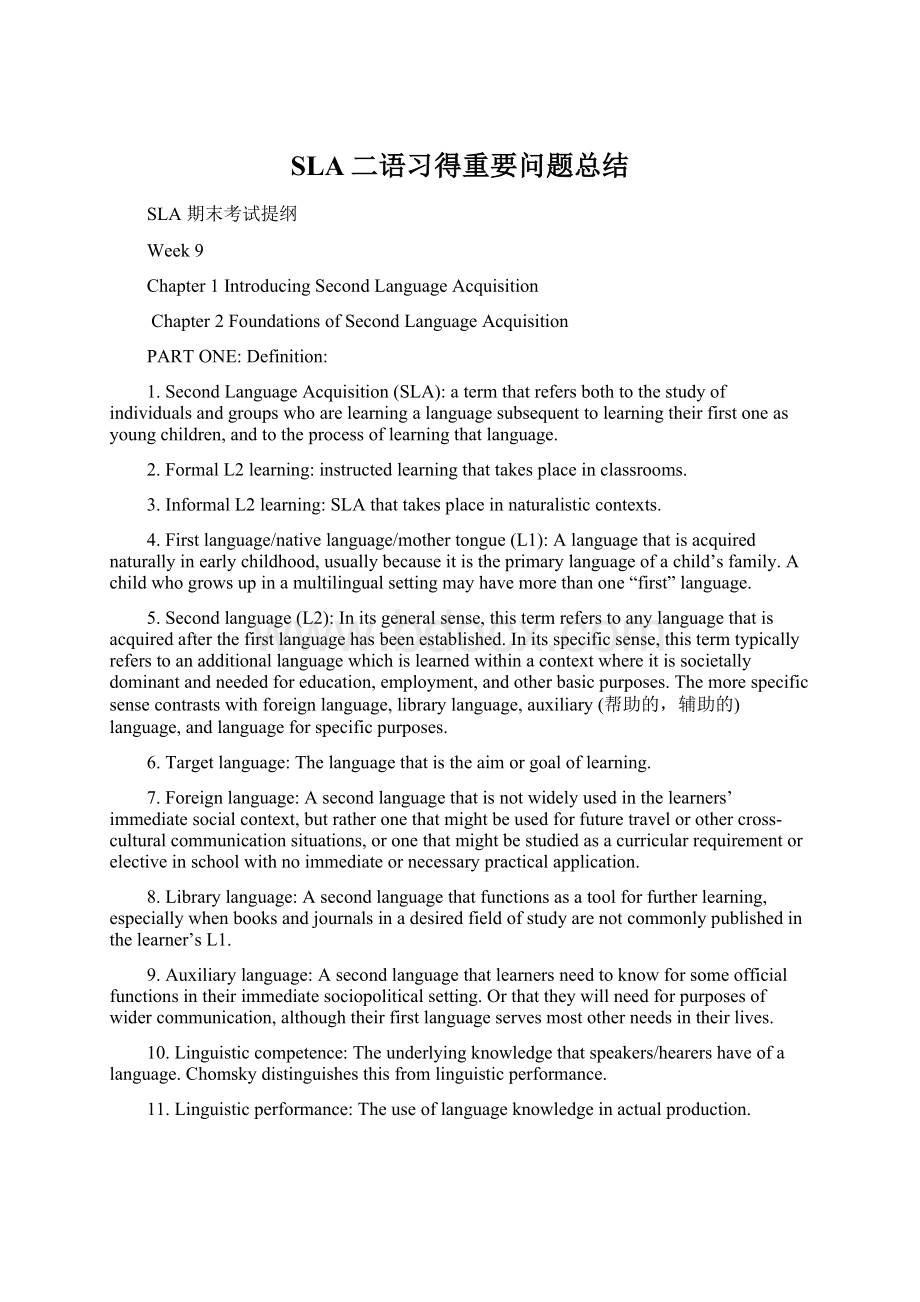SLA二语习得重要问题总结Word文档下载推荐.docx
《SLA二语习得重要问题总结Word文档下载推荐.docx》由会员分享,可在线阅读,更多相关《SLA二语习得重要问题总结Word文档下载推荐.docx(35页珍藏版)》请在冰豆网上搜索。

3.InformalL2learning:
SLAthattakesplaceinnaturalisticcontexts.
4.Firstlanguage/nativelanguage/mothertongue(L1):
Alanguagethatisacquirednaturallyinearlychildhood,usuallybecauseitistheprimarylanguageofachild’sfamily.Achildwhogrowsupinamultilingualsettingmayhavemorethanone“first”language.
5.Secondlanguage(L2):
Initsgeneralsense,thistermreferstoanylanguagethatisacquiredafterthefirstlanguagehasbeenestablished.Initsspecificsense,thistermtypicallyreferstoanadditionallanguagewhichislearnedwithinacontextwhereitissocietallydominantandneededforeducation,employment,andotherbasicpurposes.Themorespecificsensecontrastswithforeignlanguage,librarylanguage,auxiliary(帮助的,辅助的)language,andlanguageforspecificpurposes.
6.Targetlanguage:
Thelanguagethatistheaimorgoaloflearning.
7.Foreignlanguage:
Asecondlanguagethatisnotwidelyusedinthelearners’immediatesocialcontext,butratheronethatmightbeusedforfuturetravelorothercross-culturalcommunicationsituations,oronethatmightbestudiedasacurricularrequirementorelectiveinschoolwithnoimmediateornecessarypracticalapplication.
8.Librarylanguage:
Asecondlanguagethatfunctionsasatoolforfurtherlearning,especiallywhenbooksandjournalsinadesiredfieldofstudyarenotcommonlypublishedinthelearner’sL1.
9.Auxiliarylanguage:
Asecondlanguagethatlearnersneedtoknowforsomeofficialfunctionsintheirimmediatesociopoliticalsetting.Orthattheywillneedforpurposesofwidercommunication,althoughtheirfirstlanguageservesmostotherneedsintheirlives.
10.Linguisticcompetence:
Theunderlyingknowledgethatspeakers/hearershaveofalanguage.Chomskydistinguishesthisfromlinguisticperformance.
11.Linguisticperformance:
Theuseoflanguageknowledgeinactualproduction.
12.Communicativecompetence:
Abasictenet(原则、信条、教条)ofsociolinguisticsdefinedas“whataspeakerneedstoknowtocommunicateappropriatelywithinaparticularlanguagecommunity”(Saville-Troike2003)
13.Pragmaticcompetence:
Knowledgethatpeoplemusthaveinordertointerpretandconveymeaningwithincommunicativesituations.
14.Multilingualism:
Theabilitytousemorethanonelanguage.
15.Monolingualism:
Theabilitytouseonlyonelanguage.
16.Simultaneousmultilingualism:
Abilitytousemorethanonelanguagethatwereacquiredduringearlychildhood.
17.Sequentialmultilingualism:
AbilitytouseoneormorelanguagesthatwerelearnedafterL1hadalreadybeenestablished.
18.Innatecapacity:
Anaturalability,usuallyreferringtochildren’snaturalabilitytolearnoracquirelanguage.
19.Childgrammar:
Grammarofchildrenatdifferentmaturationallevelsthatissystematicintermsofproductionandcomprehension.
20.Initialstate:
Thestartingpointforlanguageacquisition;
itisthoughttoincludetheunderlyingknowledgeaboutlanguagestructuresandprinciplesthatareinlearners’headsattheverystartofL1orL2acquisition.
21.Intermediatestate:
Itincludesthematurationalchangeswhichtakeplacein“childgrammar”,andtheL2developmentalsequencewhichisknownaslearnerlanguage.
22.Finalstate:
TheoutcomeofL1andL2leaning,alsoknownasthestablestateofadultgrammar.
23.Positivetransfer:
AppropriateincorporationofanL1structureorruleinL2structure.
24.Negativetransfer:
InappropriateinfluenceofanL1structureorruleonL2use.Alsocalledinterference.
25.Poverty-of-the-stimulus:
TheargumentthatbecauselanguageinputtochildrenisimpoverishedandtheystillacquireL1,theremustbeaninnatecapacityforL1acquisition.
26.Structuralism:
Thedominantlinguisticmodelofthe1950s,whichemphasizedthedescriptionofdifferentlevelsofproductioninspeech.
27.Phonology:
Thesoundsystemsofdifferentlanguagesandthestudyofsuchsystemsgenerally.
28.Syntax:
Thelinguisticsystemofgrammaticalrelationshipsofwordswithinsentences,suchasorderingandagreement.
29.Semantics:
Thelinguisticstudyofmeaning.
30.Lexicon:
Thecomponentoflanguagethatisconcernedwithwordsandtheirmeanings.
31.Behaviorism:
Themostinfluentialcognitiveframeworkappliedtolanguagelearninginthe1950s.Itclaimsthatlearningistheresultofhabitformation.
32.Audiolingualmethod:
Anapproachtolanguageteachingthatemphasizesrepetitionandhabitformation.Thisapproachwaswidelypracticedinmuchoftheworlduntilatleastthe1980s.
33.Transformational-GenerativeGrammar:
Thefirstlinguisticframeworkwithaninternalfocus,whichrevolutionizedlinguistictheoryandhadprofoundeffectonboththestudyoffirstandsecondlanguages.Chomskyarguedeffectivelythatthebehavioristtheoryoflanguageacquisitioniswrongbecauseitcannotexplainthecreativeaspectsoflinguisticability.Instead,humansmusthavesomeinnatecapacityforlanguage.
34.PrinciplesandParameters(model):
TheinternallyfocusedlinguisticframeworkthatfollowedChomsky’sTransformational-GenerativeGrammar.ItrevisedspecificationsofwhatconstitutesinnatecapacitytoincludemoreabstractnotionsofgeneralprinciplesandconstraintscommontohumanlanguageaspartofaUniversalGrammar.
35.Minimalistprogram:
TheinternallyfocusedlinguisticframeworkthatfollowedChomsky’sPrinciplesandParametersmodel.Thisframeworkaddsdistinctionsbetweenlexicalandfunctionalcategorydevelopment,aswellasmoreemphasisontheacquisitionoffeaturespecificationasapartoflexicalknowledge.
36.Functionalism:
AlinguisticframeworkwithanexternalfocusthatdatesbacktotheearlytwentiethcenturyandhasitsrootsinthePragueSchool(布拉格学派)ofEasternEurope.Itemphasizestheinformationcontentofutterancesandconsiderslanguageprimarilyasasystemofcommunication.FunctionalistapproacheshavelargelydominatedEuropeanstudyofSLAandarewidelyfollowedelsewhereintheworld.
37.Neurolinguistics:
Thestudyofthelocationandrepresentationoflanguageinthebrain,ofinteresttobiologistsandpsychologistssincethenineteenthcenturyandoneofthefirstfieldstoinfluencecognitiveperspectivesonSLAwhensystematicstudybeganin1960s.
38.Criticalperiod:
ThelimitednumberofyearsduringwhichnormalL1acquisitionispossible.
39.CriticalPeriodHypothesis:
TheclaimthatchildrenhaveonlyalimitednumberofyearsduringwhichtheycanacquiretheirL1flawlessly;
iftheysufferedbraindamagetothelanguageareas,brainplasticityinchildhoodwouldallowotherareasofthebraintotakeoverthelanguagefunctionsofthedamagedareas,butbeyondacertainage,normallanguagedevelopmentwouldnotbepossible.ThisconceptiscommonlyextendedtoSLAaswell,intheclaimthatonlychildrenarelikelytoachievenativeornear-nativeproficiencyinL2.
40.Informationprocessing(IP):
AcognitiveframeworkwhichassumesthatSLA(likelearningofothercomplexdomains)proceedsfromcontrolledtoautomaticprocessingandinvolvesprogressivereorganizationofknowledge.
41.Connectionism:
Acognitiveframeworkforexplaininglearningprocesses,beginninginthe1980sandbecomingincreasinglyinfluential.ItassumesthatSLAresultsfromincreasingstrengthofassociationsbetweenstimuliandresponses.
42.Variationtheory:
AmicrosocialframeworkappliedtoSLAthatexploressystematicdifferencesinlearnerproductionwhichdependoncontextsofuse.
43.Accommodationtheory:
AframeworkforstudyofSLAthatisbasedonthenotionthatspeakersusuallyunconsciouslychangetheirpronunciationandeventhegrammaticalcomplexityofsentencestheyusetosoundmorelikewhomevertheyaretalkingto.
44.Socioculturaltheory(SCT):
AnapproachestablishedbyVygotskywhichclaimsthatinteractionnotonlyfacilitateslanguagelearningbutisacausativeforceinacquisition.Further,alloflearningisseenasessentiallyasocialprocesswhichisgroundedinsocioculturalsettings.
45.Ethnography(人种论、民族志)ofcommunication:
AframeworkforanalysisoflanguageanditsfunctionsthatwasestablishedbyHymes(1966).Itrelateslanguageusetobroadersocialandculturalcontexts,andappliesethnographicmethodsofdatacollectionandinterpretationtostudyoflanguageacquisitionanduse.
46.Acculturation(文化适应):
LearningthecultureoftheL2communityandadaptingtothosevaluesandbehaviorpatterns.
47.AcculturationModel/Theory:
Schumann’s(1978)theorythatidentifiesgroupfactorssuchasidentityandstatuswhichdeterminesocialandpsychologicaldistancebetweenlearnerandtargetlanguagepopulations.HeclaimstheseinfluenceoutcomesofSLA.
48.Socialpsychology:
Asocietalapproachinresearchandtheorythatallowsexplorationofissuessuchashowidentity,status,andvaluesinfluenceL2outcomesandwhy.Ithasdisciplinarytiestobothpsychologicalandsocialperspectives.
PARTTWO:
Short&
Longanswers:
Chapter1
1.Whatarethesimilaritiesanddifferencesbetweenlinguists,psycholinguist,sociolinguistsandsocialpsycholinguistsP3
(1)Linguistsemphasizethecharacteristicsofthedifferencesandsimilaritiesinthelanguagesthatarebeinglearned,andthelinguisticcompetence(underlyingknowledge)andlinguisticperformance(actualproduction